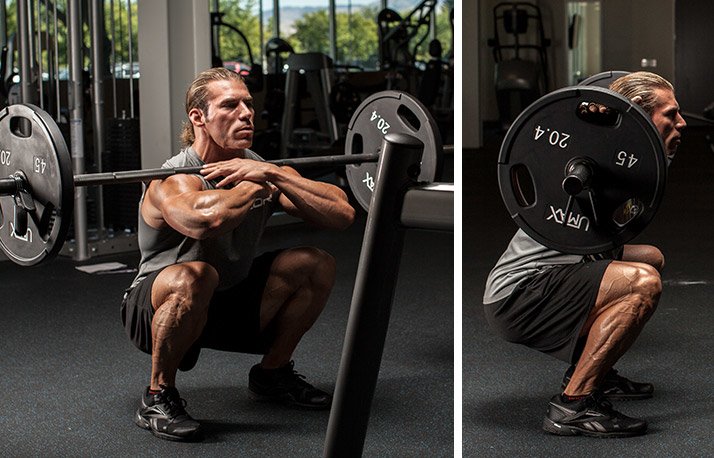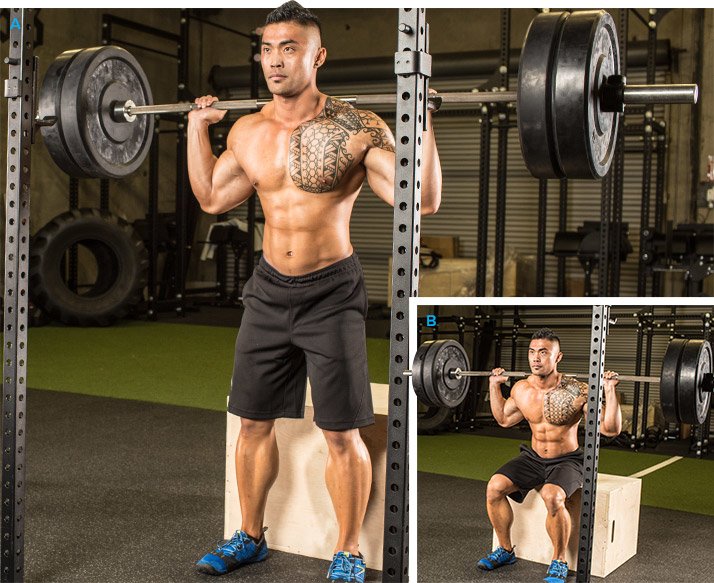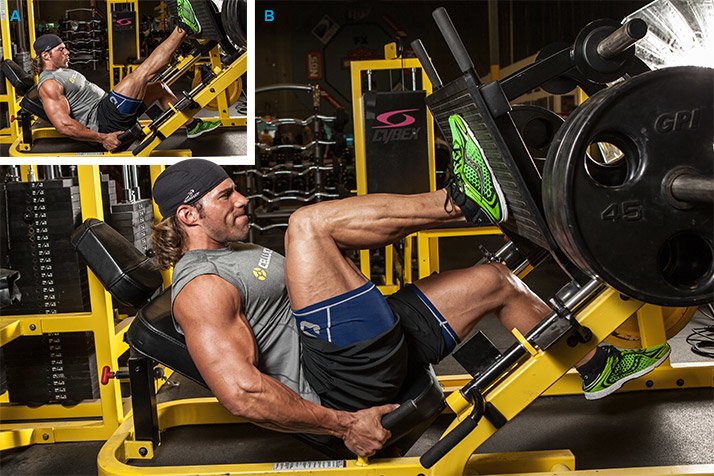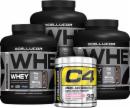
Craig Capurso's 14 Tips For Bigger Legs
Overcome poor leg development with IFBB physique pro Craig Capurso's incredible array of training tips and his unorthodox approach to leg day!
Craig Capurso has worn a lot of hats. Once a Wall Street commodities trader, the successful entrepreneur and Cellucor sponsored athlete traded in his suit and tie for a lifting belt and gloves. But it's what's under the hat we're most interested in, because Craig's leg-day methods are both incredibly unorthodox and relentless.
So if the vanilla approach to leg training isn't working for you, Craig has some incredibly useful tips when it comes to flipping the switch for leg growth.
1What would you say is the most overrated leg movement?
The leg extension—it serves no "functional" purpose. There's never a situation in which you're going to have to do a leg extension in life, unless you're bouncing a baby off your ankles. Aesthetics-wise, it does allow you to squeeze the lower quad, but in my opinion the benefit doesn't outweigh the cost. The anterior ligament of the knee (ACL) takes a lot of strain, which can weaken it in the joint. I think there are much more beneficial movements that hit the quads.
2What do you consider the most underrated leg movement?
I'd say it's a combination move of a bodyweight glute bridge with a roll-out—sometimes called a bridge roll-out—targeting the hamstrings and glutes. I do them with my shoulders on the ground and my feet on a foam roller.
I do a glute bridge and then, squeezing my glutes and hamstrings, I curl the roller pad in and then roll it out. You go into almost a reverse plank position in which your heels and ankles are touching the roller and your shoulders are on the floor.
Craig Capurso Exercise Demonstration: Glute Bridge Rollouts
Watch the video - 00:15
When we train the glutes and hams, we often don't hold the contraction—we just go through the movement, whether it's a leg curl or a squat. Few people really squeeze those muscle groups. This movement is completely about the mind-muscle connection; there's no other way to do it without squeezing it out.
After just a few reps, you'll quickly find out that it targets those muscles like nothing you've ever done before, especially the roll-out. It can be done with either one or two legs at a time.
3Tell us about what you consider your number one leg movement.
Squats, for sure. I'm sorry the answer is boring. The weight of the world is on your shoulders; it's either going to crush you or not. By doing squats weekly it's very easy to track your best effort and your progress and determine whether you're making gains in strength. The squat is a complete mass builder that releases hormones sure to bring up your legs that you won't get with other exercises.
4What advanced intensity principles work best with squats?
You can try a very challenging variation at the bottom called pause reps. At the bottom of the movement, before you ascend, you simply sit in that hole and hold it for a pause with the weight on your shoulders. That may not seem like much, but in that fully stretched position, you completely negate the elastic energy that builds up on the negative rep.

With no bounce or elastic energy at the bottom, it's all about you powering the weight up—the real nitty-gritty. Essentially, the pause squat allows you to build up your strength during the bottom portion of the movement because you've made it harder.
5What other techniques allow you to get more out squats?
For one, you can use a number of different variations. You can use a narrow stance and focus on the outer-quad sweeps, or you can go sumo and focus on the glutes and inner thighs. There are a number of other good squat variations, like front squats. I'd say that, over a given month, I do 50 percent traditional back squats, and the other half is composed of different variations.
One of the fastest and quickest ways to add intensity to your training is to use strategic rest timing. Say you're doing 5 sets with a minute of rest between each set. You simply cut your rest periods in half to 30 seconds. That's going to intensify the shit out of any exercise.
6How does leg training fit into your split?
I've followed many different splits over the course of my career. I actually worked my way up to squatting 405 pounds for 20 reps with no belt, and I did that by squatting every other day. That kind of frequency increased my lactate threshold and my endurance capacity. But I didn't do an extensive squat workout every other day—I warmed up, did just one set of 20, and that was it. It was just enough that it allowed me to not get so sore that I was hobbling to the toilet or down the stairs.
7
How did you approach that challenge?
Heavy volume training (HVT) is a training philosophy that I follow. Basically, it forces you to recruit more muscle fibers when the fast-twitch ones start to fail. In my experience, that starts to happen at about 15 reps. So I started with a weight I knew I could handle for 20 reps—about 80 percent of my maximum, or a weight that you can complete 20 reps with, stopping just short of failure—and increased the weight a little each week. It took me about a month and a half to get to 405 pounds for 20.
8What set-and-rep schemes do you normally follow when training legs?
I like training every rep range because I want to be strong in my fives and killer in my 10s, but I also want to be strong in the 20-rep range. I do that by training for 15-20 reps for a lighter set, then I'll drop the reps by doing a heavy weight, and then I'll go back and forth for 4-6 sets. I do this with squats and leg presses, and I call them zig-zags.
You have to adjust the weights accordingly when you go back up and down—what you did on your first round might not be what you can do on your second or third round as fatigue starts to set in. It builds pretty good leg strength and endurance.
9Say you're training alone. What's the best way to increase intensity without a partner pushing or spotting you?
Squat in a power rack and set the safeties low enough so that in the bottom you're safe and can bail on the lift if you have to. You can train to failure and not be afraid to fail.
Many people are afraid to fail, especially when training alone. Don't be afraid to drop the weight—that's what the safety bars are there for. I've probably dropped the weight some 25 times in my life and I was happy to do it each time. That means I was pushing myself until I couldn't handle it anymore. I'd say this technique is definitely underrated.
10What's the biggest mistake you see other people make when training legs?
When squatting, I often see people lean and let their knees drift forward. The best way to practice the squat is to sit in a chair. When you sit in a chair, your knees don't move forward. Instead, you have to sit all the way back. Start doing box squats to practice this. After you master them, you can remove the box.

I also don't believe that squats should be avoided. I believe that it's just a matter of people not learning the proper technique. Many people even rehab doing squats, kicking their hips back. Doing it properly is key wherever you are in your training.
11What's the biggest mistake you've made when training legs?
I was squatting up and down instead of back and down. I did the movement wrong for years—all through high school. A lot of well-meaning high-school coaches don't know what they're talking about. So when I got to college, the first thing we did was squats 101. We had to sit on an unstable Swiss ball while squatting, but we had a partner to catch us. That's one reason using a box or chair is so important: You have to sit back.
12Do you have a favorite way to end your workout for a killer leg pump?
I usually like to do some kind of single-leg ascending-rep variation and burn my legs out one at a time. For example, I might do single-leg presses with a weight I could use with a single leg with three plates, four plates, or five.

Single-leg leg press
You can start with 2 reps for the right leg and 2 for the left, then 4, then 6, 8, and 10. You might even go higher—15 or more. If that's not enough, you can then work your way back down, again alternating sides, this time in descending order.
13What's the best advice you've ever received about training legs?
Don't sacrifice form for weight. Check your ego at the door. Squats are the one exercise that, if you're doing them right with 135 pounds, squeezing the right muscles at the right times and using different variations, they can be just as effective at building muscle as someone who is doing 500 pounds the wrong way.
14When people ask you what your secret to big legs is, what do you tell them?
Try to recruit as many muscle fibers as possible until failure. At that point you're basically maximizing all your effort. When a muscle fires, it's training at 100 percent of its capacity. But you're often not training all of your muscle fibers—not even close. You may be training only the outer shell. Your job is to try and find a way to recruit as many as possible to maximize growth.



